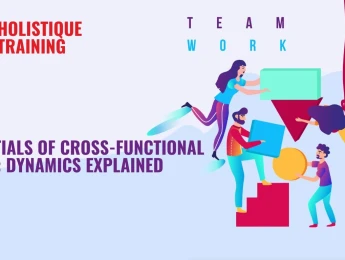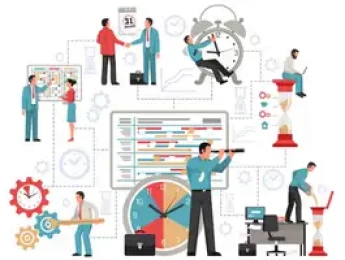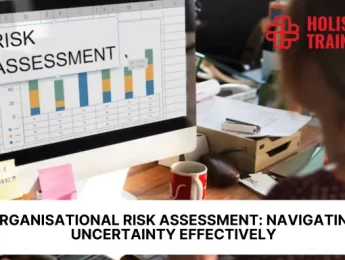Introduction
In today's dynamic business landscape, where agility and innovation reign supreme, traditional hierarchical structures are giving way to more fluid and collaborative approaches. One such approach gaining prominence is using cross-functional teams (CFTs). These teams, composed of members from different functional areas within an organisation, bring diverse expertise together to tackle specific projects or objectives. By breaking down silos and fostering collaboration across departments, cross-functional teams not only enhance problem-solving capabilities but also drive organisational agility and efficiency.
What is a Cross-Functional Team?
A cross-functional team is a group of individuals with different functional expertise working towards a common goal. Unlike traditional teams organised by department or hierarchy, CFTs are intentionally composed to include members from various disciplines such as marketing, engineering, finance, operations, and more. This diversity ensures that the team can approach problems from multiple perspectives and leverage a broad range of skills and knowledge.
Cross-functional teams (CFTs) are purposefully designed groups composed of members from diverse functional areas within an organisation. They are structured to leverage the unique expertise, skills, and perspectives of individuals across different departments to achieve specific goals or solve complex problems. Understanding the purpose and key components of CFTs is crucial for harnessing their potential and maximising their effectiveness within an organisation.
Purpose of Cross-Functional Teams
The primary purpose of cross-functional teams is to foster collaboration and integration across organisational boundaries. By bringing together individuals with diverse backgrounds, knowledge, and experience, CFTs aim to:
- Enhance Problem-Solving: CFTs are particularly adept at tackling complex challenges requiring input and insights from multiple disciplines. By pooling diverse expertise, they can identify innovative solutions and alternative approaches that may not be apparent within siloed departments.
- Drive Innovation: The intersection of different perspectives within CFTs stimulates creativity and fosters a culture of innovation . By encouraging brainstorming and idea generation from various viewpoints, CFTs can develop groundbreaking ideas and strategies that differentiate the organisation in competitive markets.
- Optimise Decision-Making: CFTs streamline decision-making processes by reducing bureaucracy and eliminating siloed thinking. Timely access to diverse perspectives allows for more informed and comprehensive decision-making, leading to quicker responses to market changes and customer needs.
- Facilitate Cross-Functional Learning: Participation in CFTs provides opportunities for professional development and knowledge sharing across functional boundaries. Team members gain insights into different aspects of the business, broaden their skill sets, and develop a deeper understanding of how their roles contribute to organisational success.
Components of Cross-Functional Teams
Successful cross-functional teams share several key components that contribute to their effectiveness and ability to achieve goals:
Diverse Expertise:
CFTs comprise members from various functional areas such as marketing, finance, operations, IT, and more. Each member brings specialised knowledge, skills, and perspectives that are essential for comprehensive problem-solving and decision-making.
Clear Objectives:
CFTs operate with clearly defined goals and objectives that align with the organisation's strategic priorities. These objectives serve as guiding principles for team activities and ensure alignment across different functional areas.
Collaborative Environment:
A supportive team culture characterised by open communication, mutual respect, and trust is essential for fostering collaboration within CFTs. Team members are encouraged to share ideas, challenge assumptions, and work together towards common goals.
Effective Leadership:
CFTs' leadership is critical in guiding team dynamics, facilitating decision-making, and resolving conflicts. Effective leaders promote a shared vision, empower team members, and create professional growth and development opportunities.
Structured Processes:
Clear roles, responsibilities, and workflows are established within CFTs to streamline operations and minimise confusion. Structured processes ensure that tasks are assigned effectively, deadlines are met, and progress is monitored closely.
Accountability:
Each team member is accountable for their contributions towards achieving team objectives. Accountability mechanisms, such as performance metrics and regular progress reviews, help maintain focus and drive results within CFTs.
Continuous Improvement:
CFTs embrace a culture of continuous improvement by seeking feedback, evaluating outcomes, and refining strategies based on lessons learned. This iterative approach ensures the team remains adaptive and responsive to evolving challenges and opportunities.
Cross-functional teams (CFTs) are integral to modern organisations striving for agility, innovation, and competitive advantage. By harnessing the diverse expertise and collaborative potential of team members from different functional areas, CFTs can drive organisational success, foster a culture of innovation, and effectively achieve strategic objectives. Understanding the purpose and key components of CFTs provides organisations with a framework for building and managing high-performing teams that deliver sustainable value and adaptability in today's dynamic business environment.
Why is Having a Cross-Functional Team Essential?
In the modern business environment characterised by rapid change and increasing complexity, adapting quickly and innovating effectively is crucial for staying competitive. Cross-functional teams offer several key benefits that contribute to organisational success:
Innovation and Creativity
Cross-functional teams are hotbeds of innovation and creativity. By bringing together individuals with diverse backgrounds, skills, and perspectives, CFTs are uniquely positioned to generate novel ideas and breakthrough solutions. Unlike traditional teams limited by homogeneous thinking, CFTs foster a culture of innovation where different viewpoints collide, intersect, and spark new possibilities. This diversity of thought enhances problem-solving capabilities and stimulates a continuous flow of fresh ideas essential for staying ahead in competitive markets.
Speed and Efficiency
In the fast-paced business environment, agility and speed are paramount. Cross-functional teams excel in streamlining processes and accelerating decision-making. By eliminating the silos that often slow down communication and decision-making, CFTs reduce bureaucratic hurdles and empower teams to respond swiftly to market changes, customer feedback, and emerging opportunities. This agility is critical in seizing competitive advantages and maintaining relevance in dynamic industries where speed can make the difference between success and irrelevance.
Improved Problem-Solving
Complex challenges rarely fall neatly within the purview of a single department or function. Cross-functional teams are tailor-made for tackling multifaceted problems that require diverse expertise and collaborative effort. Whether it's launching a new product, optimising supply chain logistics, or enhancing customer experience, CFTs draw upon the collective wisdom of experts from various disciplines. This holistic approach ensures comprehensive problem analysis and generates robust solutions that consider a broad spectrum of factors, from technical feasibility to market acceptance.
Employee Engagement and Development
Gallup’s State of the Global Workplace report highlights that a significant 85% of employees are not fully engaged at work. These declining rates of employee engagement pose a serious threat to organisational productivity. Here’s when participation in cross-functional teams comes in to save the day. Organisations demonstrate trust and recognition of their skills by involving team members in projects beyond their immediate roles. This expanded responsibility fosters a sense of ownership and pride in contributing to significant organisational outcomes. Moreover, exposure to diverse perspectives and collaboration with colleagues from different departments enriches professional growth, broadens skill sets, and nurtures future leaders adept at navigating complex, cross-functional challenges.
Organisational Alignment and Strategy Execution
Cross-functional teams play a pivotal role in aligning organisational efforts with strategic objectives. By assembling diverse stakeholders around a common goal, CFTs ensure that initiatives align closely with the organisation's overarching mission and vision. This alignment enhances strategic execution by bridging the gap between strategic intent and operational realities. As a result, CFTs serve as catalysts for driving change, executing initiatives with precision, and achieving measurable outcomes that contribute to long-term organisational success.
Adaptability and Resilience
Organisational adaptability is non-negotiable in an era marked by rapid technological advancements, market disruptions, and geopolitical shifts. Cross-functional teams embody adaptability by their very nature—flexible, responsive, and adept at navigating ambiguity. By fostering a culture of collaboration and continuous learning, CFTs empower organisations to pivot swiftly in response to external changes, capitalise on emerging opportunities, and mitigate risks effectively. This resilience enables organisations to thrive amidst uncertainty and sustain growth over the long term.
In summary, the importance of cross-functional teams in modern organisations cannot be overstated. Beyond merely enhancing operational efficiency, CFTs embody a strategic imperative—a paradigm shift towards collaborative, agile, and innovative organisational cultures. By harnessing the collective expertise of diverse disciplines, CFTs propel organisations towards sustainable growth, competitive advantage, and enduring success in an increasingly interconnected global marketplace. Embracing and leveraging the power of cross-functional teams is not just a strategic choice but a transformative journey towards excellence and leadership in the 21st-century business landscape.
Steps to Build an Effective Cross-Functional Team
Building an effective cross-functional team (CFT) requires deliberate planning, strategic alignment, and meticulous execution. While the benefits of CFTs are substantial, their success hinges on how well they are structured and managed from inception. Here are essential steps to build a robust and high-performing cross-functional team:
1. Define Objectives and Scope
The foundation of any cross-functional team is clarity of purpose. Begin by defining the team's objectives, goals, and scope of work. Clearly articulate what the team aims to achieve and how its efforts will contribute to broader organisational goals. This ensures alignment across departments and provides a guiding framework for team members to rally around.
2. Identify Key Stakeholders and Expertise
Identify the key stakeholders whose involvement is essential to the team's objectives' success. These stakeholders should represent diverse functional areas and possess relevant expertise and insights. Consider the specific skills and knowledge required to address the challenges or opportunities at hand. Involving stakeholders early in the process ensures that the team composition reflects the necessary breadth of expertise and perspectives.
3. Select Team Members Thoughtfully
Carefully select team members based on their expertise, skills, and ability to collaborate effectively across functional boundaries. Diversity in background, experience, and thinking styles is crucial for generating innovative solutions and avoiding groupthink. Look for individuals who are open-minded, adaptable, and willing to contribute their unique perspectives to achieve shared goals. It's also important to consider team dynamics and balance leadership styles and communication preferences.
4. Establish Clear Roles and Responsibilities
Define clear roles, responsibilities, and expectations for each team member. Outline how decisions will be made, how communication channels will operate, and how conflicts or disagreements will be resolved. Clarity in roles minimises confusion and ensures that each member understands their contribution to the team's success. Establishing accountability mechanisms and performance metrics further reinforces a sense of ownership and commitment among team members.
5. Foster a Collaborative Environment
Create a supportive and collaborative environment where team members feel empowered to share ideas, challenge assumptions, and collaborate effectively. Encourage open communication, active listening, and respectful debate to harness the team's collective intelligence. Foster a culture of trust and psychological safety where diverse viewpoints are valued, and contributions are acknowledged. Regular team-building activities, workshops, and brainstorming sessions can strengthen interpersonal relationships and enhance team cohesion.
6. Provide Resources and Support
Ensure the team has access to the necessary resources, tools, and support to execute their tasks effectively. This includes technological infrastructure, budgetary allocations, and administrative support. Clear any organisational barriers or bureaucratic hurdles that may impede the team's progress. Empower team members with training opportunities, mentorship, and professional development initiatives to enhance their skills and capabilities throughout the project lifecycle.
7. Establish Communication Channels
Establish robust communication channels to facilitate ongoing dialogue, information sharing, and decision-making within the team. Utilise project management tools, collaboration platforms, and regular meetings to keep team members informed and aligned with project milestones. Define protocols for reporting progress, addressing challenges, and escalating issues as needed. Effective communication fosters transparency, minimises misunderstandings, and promotes collective accountability towards achieving shared objectives.
8. Monitor Progress and Adapt
Monitor the team's progress towards achieving objectives and milestones. Track key performance indicators (KPIs) to assess productivity, efficiency, and impact. Regularly evaluate the team's dynamics, effectiveness, and alignment with strategic priorities. Be prepared to adjust team composition, workflows, or strategies based on feedback and evolving organisational needs. Adaptability is key to overcoming challenges, seizing opportunities, and maintaining momentum throughout the project lifecycle.
In short, building a successful cross-functional team requires a strategic approach that emphasises clarity, collaboration, and continuous improvement. By defining clear objectives, assembling diverse expertise, fostering a collaborative environment, and providing adequate support, organisations can unlock the full potential of cross-functional teams to drive innovation, achieve strategic goals, and enhance organisational agility. Effective team building is not merely about assembling individuals; it's about creating synergies that amplify collective strengths and propel organisations towards sustained success in today's competitive business landscape.
KPI | Description | Measurement Method |
Project Completion Rate | Percentage of projects completed | Project tracking software |
Innovation Rate | Frequency of new ideas implemented | Innovation metrics and reports |
Employee Engagement Level | Degree of team member involvement | Employee surveys and feedback |
Collaboration Efficiency | Effectiveness of team collaboration | Collaboration tools and meeting audits |
Customer Satisfaction Score | Client feedback on project outcomes | Customer surveys and satisfaction scores |
Table: KPIs for successful cross-functional teams
Challenges of Having a Cross-Functional Team
While cross-functional teams (CFTs) offer significant advantages, according to Atlassian, a whopping 75% of them are dysfunctional. Cross-functional teams also present unique challenges that can impact their effectiveness and performance. Recognising and addressing these challenges proactively is essential for maximising the potential of CFTs. Here are key challenges associated with cross-functional teams:
1. Communication Barriers
Differences in communication styles, vocabulary, and priorities among team members from diverse functional backgrounds can lead to misunderstandings and inefficiencies. Technical jargon used by specialists may be unfamiliar to members from other disciplines, hindering effective communication. Misaligned expectations regarding project timelines, deliverables, or goals can further complicate communication efforts. Overcoming communication barriers requires establishing clear communication channels, promoting active listening, and fostering a shared understanding of project objectives and terminology.
2. Conflict of Priorities
Team members often prioritise goals and objectives specific to their functional area or department over the collective goals of the cross-functional team. This divergence in priorities can create friction and hinder collaboration, particularly when decisions impact multiple departments differently. Balancing individual and team objectives requires aligning incentives, setting shared goals, and promoting a collective mindset focused on achieving overarching organisational objectives rather than departmental silos.
3. Coordination and Integration Challenges
Coordinating activities and integrating workflows across different functional areas can be complex and time-consuming. Dependencies between tasks and handoffs between team members from various disciplines require careful planning and proactive management. Delays or bottlenecks in one area can ripple throughout the project, affecting timelines and overall project outcomes. Effective coordination involves mapping out interdependencies, establishing clear workflows, and implementing robust project management practices to streamline processes and minimise disruptions.
4. Team Dynamics and Trust Building
Building trust and fostering cohesive team dynamics among members from diverse backgrounds can be challenging. Differences in professional backgrounds, organisational hierarchies, and cultural norms may influence team interactions and collaboration. Establishing a supportive team environment that encourages open communication, mutual respect, and inclusivity is crucial for overcoming barriers and promoting trust. Team-building activities, regular feedback sessions, and leadership support are essential in cultivating a positive team culture where members feel valued and motivated to contribute their best.
5. Accountability and Performance Measurement
Ensuring accountability for individual contributions and overall team performance can be challenging in cross-functional settings. Without clearly defined roles, responsibilities, and performance metrics, evaluating each team member's impact on project outcomes may be difficult. Establishing transparent performance measures, setting achievable milestones, and providing regular feedback are essential for promoting accountability and fostering a culture of continuous improvement within the team.
6. Leadership and Decision-Making
Effective leadership is critical in guiding cross-functional teams towards achieving shared goals and navigating challenges. Findings from a study indicated that the organisational context, particularly factors like top management team support and organisational politics, exert a greater impact on the success of cross-functional teams compared to the teams' internal characteristics. Leaders must possess strong interpersonal skills, strategic vision, and the ability to inspire and motivate team members from diverse backgrounds. Decentralised decision-making and conflicting leadership styles can lead to ambiguity or power struggles within the team. Empowering leaders who can facilitate consensus, resolve conflicts, and promote collaboration is essential for ensuring alignment and driving successful outcomes.
7. Organisational Support and Alignment
Cross-functional teams require organisational support and alignment to thrive. Lack of top-level sponsorship, inadequate resources, or competing organisational priorities may undermine the team's efforts and hinder its success. Securing executive buy-in, allocating sufficient resources, and aligning team objectives with strategic initiatives are critical for overcoming organisational barriers and fostering an environment conducive to cross-functional collaboration.
Navigating the challenges associated with cross-functional teams requires proactive management, effective communication, and a commitment to fostering collaboration and trust among team members. By addressing communication barriers, aligning priorities, coordinating workflows, building cohesive team dynamics, promoting accountability, and providing strong leadership, organisations can harness the full potential of cross-functional teams to drive innovation, enhance agility, and achieve strategic objectives. Embracing these challenges as opportunities for growth and learning enables organisations to cultivate resilient, high-performing teams capable of delivering sustainable value in today's dynamic business environment.
Cross-Functional Teams in Project Management
Cross-functional teams (CFTs) are pivotal in project management, leveraging diverse skills and perspectives to ensure project success. Here’s how CFTs enhance project management effectiveness:
Integrated Expertise:
CFTs bring together specialists from different departments, allowing for comprehensive project planning and execution. Each member contributes unique insights that enrich project strategies and outcomes.
Improved Decision-Making:
By including stakeholders from various functional areas, CFTs facilitate well-informed decision-making. This reduces blind spots and enhances the team’s ability to anticipate challenges and opportunities.
Enhanced Flexibility:
CFTs promote adaptability by accommodating changes in project scope or requirements more effectively. Their cross-functional nature allows for swift adjustments and resource allocation as needed.
Efficient Communication:
Clear communication channels within CFTs streamline information flow and coordination. Regular updates and transparent reporting ensure all team members are aligned with project goals and timelines.
Effective Problem-Solving:
Complex project issues benefit from the diverse perspectives within CFTs. Collaborative problem-solving approaches lead to innovative solutions and mitigate risks more comprehensively.
Integrating CFTs into project management practices enhances agility, innovation, and overall project outcomes. By harnessing the collective expertise and collaboration of team members across departments, organisations can achieve greater efficiency and success in delivering projects on time and within budget. For professionals looking to master these skills and lead cross-functional teams effectively, our course, “Project Management Practitioner Programme”, offers comprehensive training in strategic project planning, team dynamics, and effective leadership, equipping you with the tools to navigate complex projects confidently and achieve measurable results.
Conclusion
In conclusion, cross-functional teams represent a powerful strategy for organisations seeking to enhance agility, foster innovation, and achieve strategic goals effectively. By leveraging diverse expertise and breaking down silos, CFTs not only solve complex problems more efficiently but also drive continuous improvement and organisational resilience. However, success hinges on thoughtful planning, effective management, and a commitment to nurturing a collaborative culture where all team members can thrive and contribute their best.
In an increasingly interconnected and fast-paced business environment, embracing the potential of cross-functional teams can propel organisations towards sustainable growth and competitive advantage. For professionals eager to cultivate cohesive and high-performing cross-functional teams, our course "How to Build a Cohesive Team for Excellence" offers targeted strategies in team dynamics, conflict resolution, and fostering a culture of collaboration. Gain practical insights and leadership skills to empower your teams and drive impactful results in today's dynamic marketplace.

























